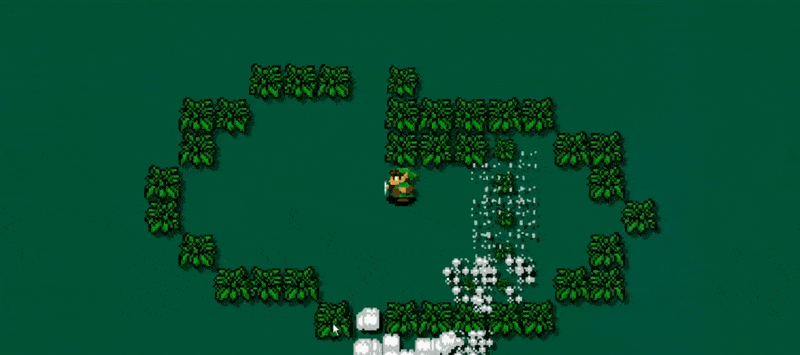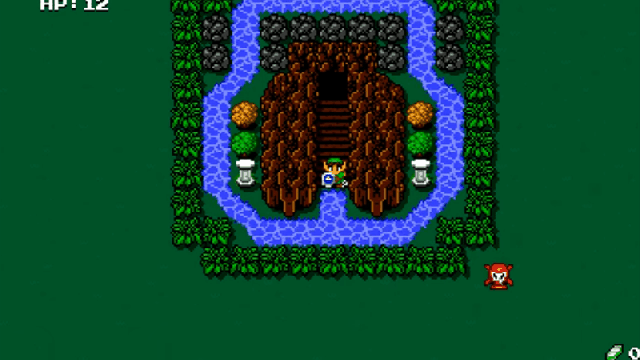GIF: Sleepy Jirachi
Following Mario Maker’s huge success, fans clamored for other Nintendo franchises to adopt easy level-creation tools. “Zelda Maker” seemed like a no-brainer, until Nintendo itself suggested such a game would be difficult to pull off. One game developer took that response from Nintendo as a challenge.
“I thought, if Nintendo this it’s too difficult then I’ll prove to them that it’s not, and I’ll make it happen,” Justin Sink, a hobbyist game creator, told Kotaku.
So in 2015, Sink got to work within Game Maker to craft a design suite that anybody could use to make a Zelda game. Just like Mario Maker, you could place elements such as enemies and landscape sprites anywhere on the digital canvas. Sink released an early version of the tool as “Zelda Maker” online, Link included, and the game blew up. People wanted to play something like Zelda Maker, they loved the idea of it.
Nintendo did not. The videos where Sink showcased Zelda Maker got copyright claimed by Nintendo on YouTube, which in turn blocked everyone from viewing the footage.
Zelda Maker’s alpha also got dinged, as MediaFire, the file-hosting website that helped Sink disseminate the game, received a DMCA notice over copyright infringement. Zelda Maker, along with the original proof of its existence, had to be taken down.

“I felt scared when they reached out to me, to be honest, because I have heard so many horror stories about Nintendo,” Sink told Kotaku. “They have really put themselves in a negative light when it comes to claiming YouTube videos, obliterating fan games, or censoring.”
But Zelda Maker did not die in 2015, not entirely. Instead of shuttering the entire project, Sink decided to rebrand and expand on it to make it his own — that was the plan all along, he claimed. He set out to create his own engine suited for the purposes of easy level design, even if it meant scrapping some of the work he had already done. Beyond the expanded functionality, Sink also had to come up with a new aesthetic for the game that, while still inspired by Zelda, couldn’t be mistaken for it.
“[Creating new art] was my biggest hurdle,” Sink said. The new game “took took a while to lock down graphically,” Sink continued, and for a while, despite capturing the eyes of the internet, his revamp of Zelda Maker was stuck in development hell. “I simply didn’t have enough technical skill to program things well,” Sink said. “Everything was badly optimised.”
Despite those troubles, “Zelda Maker” was eventually reborn as “Legend Maker,” but that, in of itself, was not the product Sink wanted share with the world. Instead, Sink used Legend Maker to create a game of his own, Runiya, an action-RPG.
Runiya hopes to take a “realistic approach” to fantasy stories, and to that end has you playing as a fallen angel who saves the people from the Rapture.
In order to differentiate itself from Zelda Maker, Sink decided to use a more limited colour palette on 16×16 sprites inspired by real-world shapes. The music, meanwhile, takes cues from Sega Arcade and Genesis melodies, all filtered through Game Boy-esque sounds. Working within these limitations is almost like a game onto itself, Sink said.
To fund all of this, Sink set up a Patreon where people provide monetary support for his new project. Donors can download early builds of Runiya, which comes packed with its own “Maker” mode that players can use to build and share levels with others.
“I’ve improved a lot of what Mario Maker tried to do by putting UI objects into categories, like foliage, enemies, buildings, NPCs,” Sink said. “I will be giving the creator more control than what Mario Maker gave, like changing music, changing weather, creating special events, adding NPCs with dialogue, [and modding]” Sink said.
He’s already noticed other players creating an unofficial Zelda mod for Legend Maker, ironically enough.
When internet commenters see news of a fan game being shut down, one of the most common responses is “why not make your own game?” The reasons are often complicated, but undeniably, pitching games based on known properties makes people take notice.
“I wanted to prove to Nintendo and a bunch of fans out there that [Zelda Maker] could be done, and if I had of started off with the name ‘Runiya‘ people wouldn’t get that point, at least not as easily,” Sink said.
“It also helped to get the word out there,” Sink said. “Legend Maker was still admittedly a rip-off name though. I was kind of scared to move too far away from letting people know I was basically creating a Zelda Maker. Who the hell knows what a Runiya is? It’s nothing, I made it up!”
With the legal threats and development hell in the rear view mirror, Runiya has finally started to stabilise in 2017. Nowadays, Sink looks back on 2015 as a learning experience that helped him define his current design philosophy.
“It was somewhat liberating to create my own name for the game, and my own mascot,” Sink said. “Zelda Maker was the first game I had made in probably 5 years minimum, [and it made me grasp] what 2D Zelda does right, and what I wish 2D Zelda did better, [which] helped me tremendously.”

Comments
9 responses to “What Happened After Nintendo Cracked Down On A Zelda Fan Game”
Because fallen angels and the rapture are so realistic, lol.
Theology time – Revelations was an open letter to a bunch of churches who at the time were going through difficulties and the purpose of Revelations was to use imagery to explain the it’s okay because god has a plan and things will be okay in the end. It was never intended to predict the future.
Shush! How dare you provide background information and context! making it harder for me to quite the bible as law such as laying down with a man and wearing cotton is all taboo! =P
“Save” people from the Rapture? Granted, the denomination I grew up in doesn’t acknowledge the concept… but it’s meant to be a good thing, yes?
Anyways, stuff Zelda. I want a Lolo Maker, damn it.
What the world needs is a Bubsy Maker.
What could possibly go wrong?
Conflating ‘obliterating’ fan games with the censoring stuff – which was Gamergate bullshit pure and simple – doesn’t exactly make one sympathise with the bloke.
What?
Hello, Clarice.
A googly-boogly to you too.